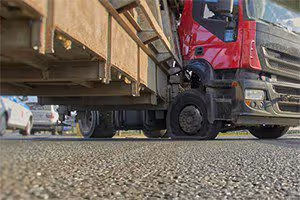
Truck accidents present a significant concern for anyone navigating New York’s roadways. These incidents often lead to serious injuries or fatalities, creating a ripple effect of hardship for victims and their families. Understanding the underlying causes of these accidents can be instrumental for both prevention and legal redress. This page will explore the common reasons behind truck accidents in the Empire State, the different kinds of collisions that may occur, and the claims process that follows.
Causes of Truck Accidents in New York
Truck accidents in New York are a concerning issue, with a range of causes that underscore the complexity of these often-devastating events. From driver error influenced by fatigue, speeding, and distractions, to mechanical failures arising from inadequate maintenance, the potential triggers are numerous and multifaceted. Add to this the state’s varying road conditions and traffic violations, and the risk factor only intensifies. Understanding these diverse causes is crucial for both preventing future accidents and aiding victims in navigating the complexities of legal redress. The following are the most common causes for commercial truck accidents.
- Driver Error – Driver error remains one of the most prevalent reasons behind truck accidents. Factors like speeding, distracted driving, and fatigue contribute significantly to these incidents. The long hours on the road and the pressure to meet tight delivery deadlines often make truck drivers susceptible to these errors, affecting their ability to make sound judgments while driving.
- Mechanical Failure – Mechanical issues are another leading cause of truck accidents. Whether it’s brake failure, a tire blowout, or engine malfunction, these issues often arise due to inadequate maintenance practices. When mechanical components fail, the results can be devastating, leading to life-threatening situations for everyone involved.
- Road Conditions – New York’s diverse road conditions also play a role in truck-related accidents. From potholes to uneven surfaces and insufficient signage, poor road conditions can make it difficult for truck drivers to maintain control, leading to severe accidents.
- Traffic Violations – Traffic violations also contribute to the accident tally. In instances where truck drivers consciously ignore traffic rules—such as running red lights or not stopping at stop signs—the risk for catastrophic outcomes increases substantially.
- Hazardous Materials Spills – Some truck accidents involve the transport of hazardous materials. When these substances spill during an accident, they add another layer of complexity to the situation. These spills can pose severe environmental and public health risks, requiring immediate and specialized response.
Types of Truck Accidents
Truck accidents come in various forms, each with its own set of dangers and implications. From head-on collisions that often result in fatalities to rear-end impacts that cause severe injuries, these incidents are always a cause for concern. Understanding these different types of truck accidents can provide valuable insights into both prevention and the legal pathways that victims may need to navigate. The following are the most common types of commercial truck accidents.
Head-on collisions between trucks and other vehicles are some of the most devastating, frequently resulting in fatalities. In contrast, rear-end collisions involve a truck colliding with another vehicle from behind, usually at high speeds, causing severe injuries or damages.
Sideswipe collisions occur when a truck and another vehicle are driving side by side and come into contact, often resulting in significant damage to the smaller vehicle.
Rollovers are another type of truck accident, made more likely by a truck’s high center of gravity; these often lead to hazardous cargo spills.
In jackknife incidents, a truck’s trailer swings out, forming a 90-degree angle with the cab, creating potential for multi-vehicle accidents.
Lastly, there are cases where a truck loses its cargo altogether, leading to additional accidents as drivers swerve to avoid debris on the roadway.
The Truck Accident Claims Process
The initial step after a truck accident involves conducting a thorough investigation to collect evidence, document the scene, and gather witness testimonials. Once this is completed, consulting an experienced legal expert is crucial. Your attorney will help you draft and file a detailed insurance claim, explaining the accident’s intricacies and the losses you’ve incurred. If initial negotiations between the involved legal parties fail, the case advances to trial. Here, a judge or jury examines the presented evidence and arguments before making a final ruling. Upon winning the case, the victim receives compensation, which could be disbursed either as a lump sum or in periodic installments.
A deep understanding of the causes and types of truck accidents in New York can offer essential insights for both prevention and legal action. Whether an accident results from human error, a mechanical fault, or other external factors, multiple avenues are available for victims seeking justice. Knowing the particular kind of truck accident and the intricacies of the claims process enables victims to prepare effectively for any legal challenges they may face, ensuring they are adequately compensated for their losses.



.avif)
.avif)